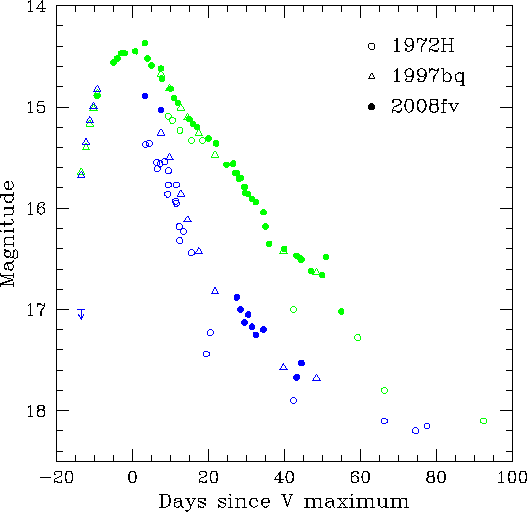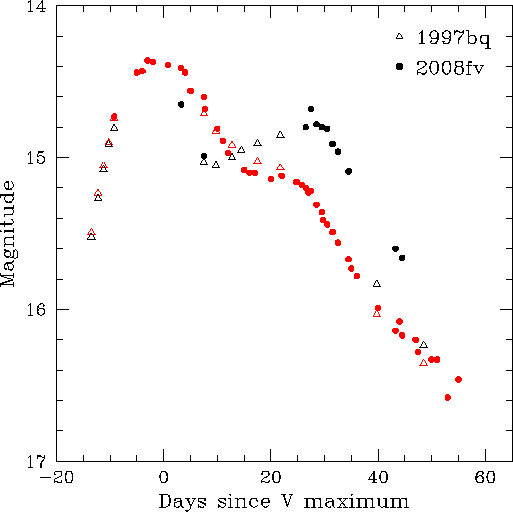|
Peremennye Zvezdy (Variable Stars) 30, No. 2, 2010 Received 10 March; accepted 15 March.
|
Article in PDF |
SN 2008fv: the Third Type Ia Supernova in NGC 3147
D. Yu. Tsvetkov1, L. Elenin2
- Sternberg
Astronomical Institute, University Ave. 13, 119992 Moscow, Russia
- Keldysh Institute of Applied Mathematics RAS, Miusskaya sq. 4, 125047 Moscow, Russia
|
Multiple outbursts of type Ia SNe in one galaxy present a unique
opportunity to study the homogeneity of these objects. NGC 3147 is
only the second known galaxy with three SNe Ia, another one is NGC
1316. We present CCD |
SN 2008fv
SN 2008fv was discovered by K. Itagaki on unfiltered CCD images
exposed with a 0.6-m reflector around September 27.78 UT at
magnitude 16.5. The new object was located at
![]() ,
,
![]() (J2000.0), which is
(J2000.0), which is
![]() east and
east and
![]() north of the
center of the galaxy NGC 3147 (Nakano 2008).
north of the
center of the galaxy NGC 3147 (Nakano 2008).
Challis (2008), on behalf of the CfA Supernova Group, reported that a spectrum (range 350-880 nm) of SN 2008fv, obtained on September 30 with the MMT at Mt. Hopkins, showed it to be a normal type-Ia supernova about one week before maximum light. This is the fourth SN discovered in NGC 3147, the former were SN I 1972H (Goranskij 1972; Barbon et al. 1973), SN Ia 1997bq (Laurie and Challis 1997; Jha et al. 2006), and SN Ib 2006gi (Itagaki 2006; Elmhamdi et al. 2010).
We started photometric monitoring of SN 2008fv soon after its discovery, on October 3, with the remotely controlled telescope of the Tzec Maun Observatory. Later we also observed the SN with four other telescopes at three different locations. The data on the telescopes and detectors are presented in Table 1.
All image reductions and photometry were made using IRAF.1
The image of NGC 3147 obtained at C60 in the ![]() band is presented
in Fig. 1. SN 2008fv and the sites of three previous SNe are
marked, as well as the local standard stars. The magnitudes of
these stars are reported in Table 2, they were calibrated on
12 photometric nights during monitoring SNe 2006gi and 2008fv.
Stars 1 and 3 were also used as standards for the photometry of SN
2006gi (Elmhamdi et al. 2010).
band is presented
in Fig. 1. SN 2008fv and the sites of three previous SNe are
marked, as well as the local standard stars. The magnitudes of
these stars are reported in Table 2, they were calibrated on
12 photometric nights during monitoring SNe 2006gi and 2008fv.
Stars 1 and 3 were also used as standards for the photometry of SN
2006gi (Elmhamdi et al. 2010).
SN 2008fv is projected on the spiral arm, and the subtraction of galaxy background is necessary for reliable photometry. The template images were constructed from frames obtained in November 2006 at C60 while monitoring SN 2006gi. After template subtraction, the magnitudes of the SN were derived by PSF fitting relative to a sequence of local standard stars.
| Telescope | D(cm) | F(cm) | CCD camera | Filters | Location | Code |
| Maksutov- | 35 | 133 | SBIG ST-10E | Mayhill, New | TM35 | |
| Newton | Mexico, USA | |||||
| Cassegrain | 70 | 1050 | Apogee AP-7p | Moscow, Russia | M70 | |
| Cassegrain | 60 | 750 | Apogee AP-47p | Nauchny, Crimea, | C60 | |
| Ukraine | ||||||
| Maksutov | 50 | 200 | Meade Pictor | Nauchny, Crimea, | C50 | |
| 416XT | Ukraine | |||||
| Newton | 50 | 250 | SBIG | Tatranska Lomnica, | S50 | |
| ST-10XME | Slovakia |
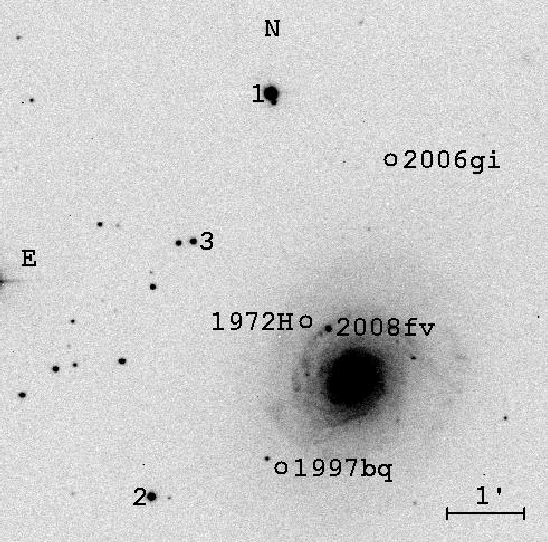 |
Fig. 1. SN 2008fv in NGC 3147. Circles indicate the sites of previous SNe, the local standard stars are marked. |
The observations of SN 2008fv at TM35 in the ![]() filters are
presented in Table 3, and the photometry in the
filters are
presented in Table 3, and the photometry in the ![]() filters
obtained with other telescopes is reported in Table 4.
filters
obtained with other telescopes is reported in Table 4.
| JD 2454000+ | JD 2454000+ | ||||||||
| 742.86 | 14.89 | 0.03 | 14.73 | 0.02 | 773.93 | 15.36 | 0.03 | 15.12 | 0.06 |
| 746.92 | 14.56 | 0.02 | 14.44 | 0.02 | 776.86 | 15.57 | 0.03 | 15.16 | 0.02 |
| 747.90 | 14.52 | 0.02 | 14.43 | 0.01 | 777.85 | 15.18 | 0.01 | ||
| 748.91 | 14.47 | 0.02 | 14.36 | 0.01 | 778.98 | 15.65 | 0.03 | 15.23 | 0.01 |
| 749.91 | 14.47 | 0.02 | 14.37 | 0.02 | 779.98 | 15.71 | 0.03 | ||
| 752.88 | 14.45 | 0.02 | 14.39 | 0.01 | 781.89 | 15.85 | 0.03 | 15.41 | 0.02 |
| 755.94 | 14.52 | 0.02 | 14.44 | 0.03 | 786.93 | 16.18 | 0.04 | 15.73 | 0.04 |
| 756.93 | 14.59 | 0.05 | 14.56 | 0.02 | 787.97 | 16.35 | 0.03 | 15.78 | 0.04 |
| 759.82 | 14.72 | 0.03 | 14.68 | 0.02 | 791.98 | 16.40 | 0.04 | 15.99 | 0.06 |
| 761.95 | 14.82 | 0.03 | 14.81 | 0.02 | 795.98 | 16.49 | 0.04 | 16.08 | 0.03 |
| 762.92 | 14.91 | 0.02 | 14.89 | 0.02 | 799.02 | 16.62 | 0.05 | 16.20 | 0.02 |
| 763.97 | 14.96 | 0.02 | 14.97 | 0.01 | 801.99 | 16.66 | 0.05 | 16.33 | 0.04 |
| 766.93 | 15.12 | 0.02 | 15.08 | 0.02 | 803.00 | 16.48 | 0.12 | 16.33 | 0.03 |
| 767.95 | 15.17 | 0.03 | 15.10 | 0.01 | 804.98 | 16.58 | 0.11 | ||
| 768.92 | 15.20 | 0.02 | 15.10 | 0.01 | 806.96 | 17.02 | 0.10 | 16.46 | 0.09 |
| 771.93 | 15.31 | 0.03 | 15.14 | 0.01 |
| JD 2454000+ | Tel. | ||||||||||
| 755.33 | 14.89 | 0.07 | 14.89 | 0.03 | 14.37 | 0.03 | 14.41 | 0.02 | 14.65 | 0.07 | M70 |
| 759.66 | 14.97 | 0.08 | 15.03 | 0.03 | 14.62 | 0.03 | 14.60 | 0.03 | 14.99 | 0.05 | S50 |
| 778.45 | 15.56 | 0.03 | 15.20 | 0.02 | 14.80 | 0.05 | C50 | ||||
| 779.56 | 16.88 | 0.04 | 15.65 | 0.02 | 15.22 | 0.02 | 14.68 | 0.07 | C60 | ||
| 780.49 | 17.00 | 0.04 | 15.70 | 0.02 | 15.31 | 0.02 | 14.78 | 0.03 | C60 | ||
| 781.59 | 17.13 | 0.03 | 15.79 | 0.03 | 15.36 | 0.02 | 14.80 | 0.03 | C60 | ||
| 782.41 | 17.05 | 0.04 | 15.86 | 0.03 | 15.44 | 0.02 | 14.81 | 0.04 | C60 | ||
| 783.55 | 17.17 | 0.05 | 15.91 | 0.03 | 15.49 | 0.02 | 14.91 | 0.04 | C60 | ||
| 784.49 | 17.25 | 0.07 | 15.94 | 0.03 | 15.56 | 0.02 | 14.96 | 0.05 | C60 | ||
| 786.42 | 17.20 | 0.06 | 16.04 | 0.04 | 15.67 | 0.02 | 15.09 | 0.06 | C60 | ||
| 795.36 | 17.67 | 0.04 | 16.47 | 0.03 | 16.14 | 0.02 | 15.60 | 0.05 | C60 | ||
| 796.48 | 17.53 | 0.03 | 16.51 | 0.03 | 16.17 | 0.03 | 15.66 | 0.05 | C60 | ||
| 799.41 | 16.28 | 0.05 | S50 | ||||||||
| 845.22 | 17.87 | 0.10 | M70 | ||||||||
| 866.21 | 18.08 | 0.09 | M70 | ||||||||
| 868.20 | 18.28 | 0.09 | M70 | ||||||||
| 894.36 | 18.98 | 0.06 | 18.90 | 0.07 | M70 |
The light curves are shown in Fig. 2. The maximum phase in the ![]() and
and ![]() bands is well-sampled by the observations, and we can
derive the dates and magnitudes of maximum light:
bands is well-sampled by the observations, and we can
derive the dates and magnitudes of maximum light: ![]() on JD 2454752,
on JD 2454752, ![]() on the same date. The rate of early
decline in the
on the same date. The rate of early
decline in the ![]() band corresponds to
band corresponds to
![]() .
From the list of type Ia SNe presented by Hicken et al. (2009), we
select three SNe with similar
.
From the list of type Ia SNe presented by Hicken et al. (2009), we
select three SNe with similar
![]() and best-observed
light curves: 1992bc, 2006ax, 2007af (Hamuy et al. 1996; Hicken et
al. 2009). We fit the light curves of SN 2008fv to those for the
three SNe listed above and find that, in the
and best-observed
light curves: 1992bc, 2006ax, 2007af (Hamuy et al. 1996; Hicken et
al. 2009). We fit the light curves of SN 2008fv to those for the
three SNe listed above and find that, in the ![]() band, the fits
for all the three objects are equally good. In the
band, the fits
for all the three objects are equally good. In the ![]() band, SN
1992bc provides the best fit, while in the
band, SN
1992bc provides the best fit, while in the ![]() band, SN 2006ax
gives the best result. The
band, SN 2006ax
gives the best result. The ![]() -band light curve cannot be fitted
well by any of these SNe, but SN 2006ax provides a slightly better
match.
-band light curve cannot be fitted
well by any of these SNe, but SN 2006ax provides a slightly better
match.
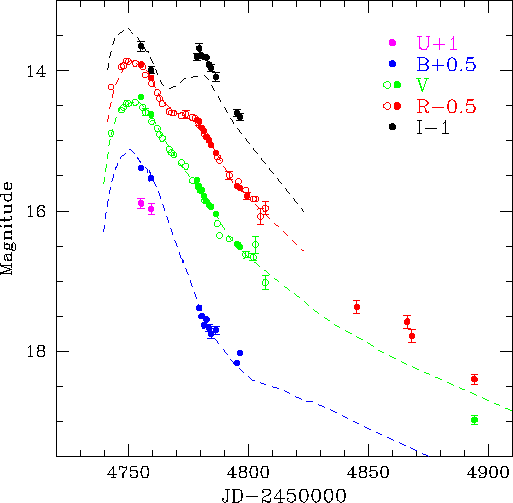 |
Fig. 2.
The light curves of SN 2008fv.
Circles show data obtained at TM35, dots are for observations at
other telescopes. The error bars are plotted only if they exceed
the size of a symbol. The dashed lines are the light curves of SN
1992bc ( |
After JD 2454820, the ![]() and
and ![]() light curves show a linear
decline with the rate 0.022 mag day
light curves show a linear
decline with the rate 0.022 mag day![]() , which is quite normal
for SNe Ia at this stage.
, which is quite normal
for SNe Ia at this stage.
SN 1972H
SN 1972H was discovered by Goranskij (1972) on a plate exposed on
1972 August 3.9 UT at the Crimean observatory of the Sternberg
Astronomical Institute. Photographic photometry in a band close to
![]() was reported by Goranskij (1972), and in the
was reported by Goranskij (1972), and in the ![]() ,
, ![]() filters
by Barbon et al. (1973). The magnitudes of the SN were
eye-estimated on the plates relative to sequences of local
comparison stars, which were calibrated photographically. While
compiling the data on the light curves of SNe, we recalibrated
these standards using photoelectric and photographic photometry
and measured the plates obtained by Goranskij (1972) with a
microphotometer (Tsvetkov 1985). Now we calibrate these stars
again on our CCD frames relative to our local standards 1 and 2.
The results confirm the conclusion by Tsvetkov (1985) that the
calibration of Barbon et al. (1973) in the
filters
by Barbon et al. (1973). The magnitudes of the SN were
eye-estimated on the plates relative to sequences of local
comparison stars, which were calibrated photographically. While
compiling the data on the light curves of SNe, we recalibrated
these standards using photoelectric and photographic photometry
and measured the plates obtained by Goranskij (1972) with a
microphotometer (Tsvetkov 1985). Now we calibrate these stars
again on our CCD frames relative to our local standards 1 and 2.
The results confirm the conclusion by Tsvetkov (1985) that the
calibration of Barbon et al. (1973) in the ![]() band is quite
accurate, but in the
band is quite
accurate, but in the ![]() band their magnitudes are systematically
too faint by about 0
band their magnitudes are systematically
too faint by about 0![]() 15. However, for some of the comparison
stars the random errors of our photographic photometry are found
to be quite large. We combine old plate measurements with the new
calibration of local standards and obtain new magnitudes for SN
1972H, which are reported in Table 5. We correct the magnitudes of
Barbon et al. (1973) for the systematic errors of their
comparison-star photometry. The resulting light curves for SN
1972H are shown in Fig. 3.
15. However, for some of the comparison
stars the random errors of our photographic photometry are found
to be quite large. We combine old plate measurements with the new
calibration of local standards and obtain new magnitudes for SN
1972H, which are reported in Table 5. We correct the magnitudes of
Barbon et al. (1973) for the systematic errors of their
comparison-star photometry. The resulting light curves for SN
1972H are shown in Fig. 3.
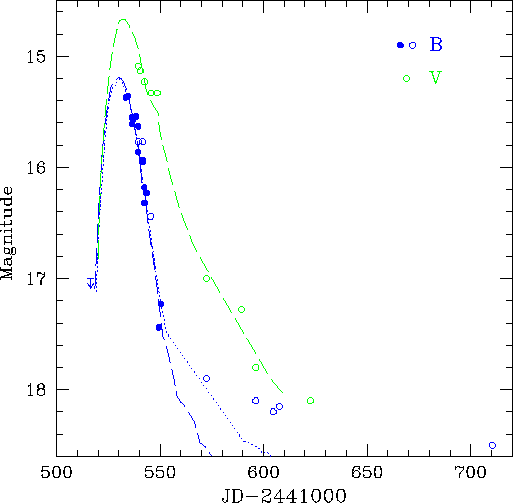 |
Fig. 3.
|
Unfortunately, no spectroscopic observations were reported for SN
1972H. The classification as type I was proposed by Barbon et al.
(1973) and was based on the shape of the light curve. We attempted
to fit the data for SN 1972H to the light curves of SNe Ia,
IaPec(1991bg class), and Ib/c, and found that the best match was
achieved for fast-declining SNe Ia, such as 1994D and 2007gi
(Richmond et al. 1995; Altavilla et al. 2004; Zhang et al. 2010).
Besides, there is a clear indication of a hump on the ![]() -band
light curve, which is never observed for SNe Ib/c or IaPec. Thus,
we may conclude that the probability of SN 1972H being a normal SN
Ia is very high. The fitting of light curves of SNe 1994D and
2007gi indicates that SN 1972H reached maximum light around JD
2441530 with
-band
light curve, which is never observed for SNe Ib/c or IaPec. Thus,
we may conclude that the probability of SN 1972H being a normal SN
Ia is very high. The fitting of light curves of SNe 1994D and
2007gi indicates that SN 1972H reached maximum light around JD
2441530 with
![]() . The match for the
. The match for the
![]() -band curve is good for the whole period covered with
observations, while in the
-band curve is good for the whole period covered with
observations, while in the ![]() band, the tail of the light curve
for SN 1972H is not fitted by the curve of SN 1994D, and only the
start of the tail is fitted by the curve of SN 2007gi. We may
suppose that the decline rate at the tail for SN 1972H is slower
than usual, or that there are large errors of the photographic
magnitudes at the late stage, perhaps due to the galaxy
background.
band, the tail of the light curve
for SN 1972H is not fitted by the curve of SN 1994D, and only the
start of the tail is fitted by the curve of SN 2007gi. We may
suppose that the decline rate at the tail for SN 1972H is slower
than usual, or that there are large errors of the photographic
magnitudes at the late stage, perhaps due to the galaxy
background.
Comparison of light and color curves for the three SNe
The light curves of SNe 1972H, 1997bq (Jha et al., 2006), and
2008fv in the ![]() and
and ![]() bands are compared in Fig. 4.
bands are compared in Fig. 4.
The curves were shifted only in time to match the dates of maximum
in the ![]() band. The striking similarity of the
band. The striking similarity of the ![]() -band light
curves for SNe 1997bq and 2008fv is the most interesting result.
The light curves in the
-band light
curves for SNe 1997bq and 2008fv is the most interesting result.
The light curves in the ![]() band are also similar, but they are
not so well-sampled, and the similarity is not so evident as for
the
band are also similar, but they are
not so well-sampled, and the similarity is not so evident as for
the ![]() curves. SN 1972H clearly shows faster declining light
curves with fainter maxima. The light curves of SNe 1997bq and
2008fv in the
curves. SN 1972H clearly shows faster declining light
curves with fainter maxima. The light curves of SNe 1997bq and
2008fv in the ![]() and
and ![]() bands are compared in Fig. 5. Again we
see a nearly perfect agreement between these objects, there is
only a slight difference of the
bands are compared in Fig. 5. Again we
see a nearly perfect agreement between these objects, there is
only a slight difference of the ![]() curves at phases 10-20 days
past maximum.
curves at phases 10-20 days
past maximum.
The color curves are presented in Fig. 5. As expected, the color
curves of SNe 1997bq and 2008fv are nearly identical, the
difference can be noticed only for the ![]() curve 10-20 days
past maximum. These SNe are clearly reddened, the comparison of
curve 10-20 days
past maximum. These SNe are clearly reddened, the comparison of
![]() color after phase 30 days with the "Lira-Phillips
relation" (Phillips et al. 1999) allows to estimate
color after phase 30 days with the "Lira-Phillips
relation" (Phillips et al. 1999) allows to estimate
![]() . The
. The ![]() color of SN 1972H is significantly
redder than the curve for SN 1994D at the phase of early decline,
but later, the color becomes even bluer than the "Lira-Phillips
relation". Note, however, that colors derived from photographic
photometry may have large errors. So we cannot make any reliable
estimate of reddening for SN 1972H and only suppose that
color of SN 1972H is significantly
redder than the curve for SN 1994D at the phase of early decline,
but later, the color becomes even bluer than the "Lira-Phillips
relation". Note, however, that colors derived from photographic
photometry may have large errors. So we cannot make any reliable
estimate of reddening for SN 1972H and only suppose that
![]() probably is in the
probably is in the
![]() range.
range.
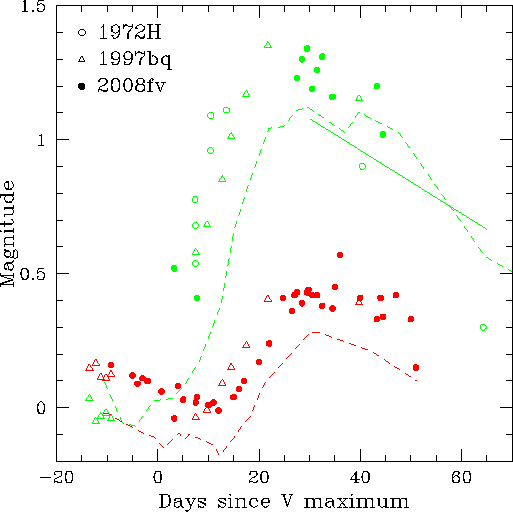 |
Fig. 6.
The |
Among the three SNe, the rate of decline in the ![]() band can be
directly determined only for SN 2008fv. Observations of this SN in
the
band can be
directly determined only for SN 2008fv. Observations of this SN in
the ![]() band started after maximum. SN 1972H was discovered after
maximum, and we have only an upper limit to constrain the rising
branch of the light curve. SN 1997bq have well-observed parts of
their light curves before and after maximum, but there is a gap
around maximum light.
band started after maximum. SN 1972H was discovered after
maximum, and we have only an upper limit to constrain the rising
branch of the light curve. SN 1997bq have well-observed parts of
their light curves before and after maximum, but there is a gap
around maximum light.
From the fitting of template light curves, we can estimate that,
for SN 1972H,
![]() ,
,
![]() ; for SN 2008fv,
; for SN 2008fv,
![]() . Jha et al. (2006) estimate
. Jha et al. (2006) estimate
![]() for SN
1997bq, and we suppose that in the
for SN
1997bq, and we suppose that in the ![]() band its light curve is
identical to that for SN 2008fv, with
band its light curve is
identical to that for SN 2008fv, with
![]() .
.
If we assume, for NGC 3147, the distance modulus ![]() and
the galactic extinction
and
the galactic extinction
![]() , as in Elmhamdi et al.
(2010), the maximum absolute magnitudes for SNe 1997bq and 2008fv
(uncorrected for extinction in the parent galaxy) are
, as in Elmhamdi et al.
(2010), the maximum absolute magnitudes for SNe 1997bq and 2008fv
(uncorrected for extinction in the parent galaxy) are ![]() ,
,
![]() , and for SN 1972H,
, and for SN 1972H, ![]() ,
, ![]() . If we
compare these data to the plots of SN Ia absolute magnitudes
versus
. If we
compare these data to the plots of SN Ia absolute magnitudes
versus
![]() reported by Hicken et al. (2009), we
find that they are within the scatter of points presenting
reported by Hicken et al. (2009), we
find that they are within the scatter of points presenting ![]() and
and ![]() , not corrected for the host-galaxy extinction, but are
significantly fainter than the mean values of
, not corrected for the host-galaxy extinction, but are
significantly fainter than the mean values of ![]() and
and ![]() .
.
After correction for the host galaxy extinction with
![]() and
and ![]() , we obtain
, we obtain
![]() for SNe 1997bq and 2008fv, which is very close to
the ridge line of the relations between
for SNe 1997bq and 2008fv, which is very close to
the ridge line of the relations between ![]() ,
, ![]() and
and
![]() . For SN 1972H, we can estimate the host galaxy
extinction, comparing its
. For SN 1972H, we can estimate the host galaxy
extinction, comparing its ![]() and
and ![]() to mean values of
to mean values of
![]() and
and ![]() for
for
![]() . The comparison
yields
. The comparison
yields ![]() and
and ![]() , which correspond to
the color excess
, which correspond to
the color excess
![]() . Such color excess means
that the
. Such color excess means
that the ![]() color for SN 1972H is significantly bluer than
the "Lira-Phillips relation" at the tail stage. But these
colors may have large errors, and even with smaller color excess
(the lower limit is about 0
color for SN 1972H is significantly bluer than
the "Lira-Phillips relation" at the tail stage. But these
colors may have large errors, and even with smaller color excess
(the lower limit is about 0![]() 1 mag), the absolute magnitudes of
SN 1972H are still within the range of dispersion on the relation
between
1 mag), the absolute magnitudes of
SN 1972H are still within the range of dispersion on the relation
between ![]() ,
, ![]() and
and
![]() .
.
Let us also consider the locations of the SNe in the host galaxy.
SN 2008fv is in the spiral arm at the distance of ![]() kpc from
the center of the galaxy, while the radius of the galaxy is 24.5
kpc. SN 1972H exploded in an interarm region, only 3.2 kpc from
the site of SN 2008fv, at
kpc from
the center of the galaxy, while the radius of the galaxy is 24.5
kpc. SN 1972H exploded in an interarm region, only 3.2 kpc from
the site of SN 2008fv, at ![]() kpc. SN 1997bq was located
outside the region of spiral structure, at
kpc. SN 1997bq was located
outside the region of spiral structure, at ![]() kpc. And the
only core-collapse SN in NGC 3147, SN Ib 2006gi, exploded at
kpc. And the
only core-collapse SN in NGC 3147, SN Ib 2006gi, exploded at
![]() kpc, well outside the boundaries of the galaxy.
kpc, well outside the boundaries of the galaxy.
The comparison of photometric data for the three type Ia SNe discovered in NGC 3147 reveals a very high similarity between two of them: SNe 1997bq and 2008fv. Not only photometric parameters, but the host-galaxy extinction is also the same for the two objects. This is quite surprising, taking into account the different environments of these objects in the host galaxy. The maximum luminosity of SNe 1997bq and 2008fv fits very well to the relation of absolute magnitude versus the initial decline rate. The data for SN 1972H are of lower quality and do not permit a definite determination of photometric parameters, but the most probable value of absolute magnitude is also in agreement with the above-mentioned relation. The results confirm the usefulness of type Ia SNe for providing accurate distance estimates required for measuring cosmological parameters.
Acknowledgements. We are grateful to S.Yu. Shugarov and
I.M. Volkov, who made some of the observations. The work of D.T.
was partly supported by the Leading Scientific Schools Foundation
under grant NSh.433.2008.2.
References:
Altavilla, G., Fiorentino, G., Marconi, M., et al., 2004, MNRAS, 349, 1344
Barbon, R., Ciatti, F., Rosino, L., 1973, Astron. Astrophys., 29, 57
Challis, P., 2008, CBET, No. 1522
Elmhamdi, A., Tsvetkov, D., Danziger, I.J., Kordi, A., 2010, preprint, arXiv:1001.0945
Goranskij, V.P., 1972, Astron. Tsirk., No. 723, 1
Hamuy, M., Phillips, M.M., Suntzeff, N.B., et al., 1996, Astron. J., 112, 2408
Hicken, M., Challis, P., Jha, S., et al., 2009, Astrophys. J., 700, 331
Itagaki, K., 2006, IAUC, No. 8751
Jha, S., Kirshner, R.P., Challis, P., et al., 2006, Astron. J., 131, 527
Laurie, S., Challis, P., 1997, IAUC, No. 6616
Nakano, S., 2008, CBET, No. 1520
Phillips, M.M., Lira, P., Suntzeff, N.B., et al., 1999, Astron. J., 118, 1766
Richmond, M.W., Treffers, R.R., Filippenko, A.V., et al., 1995, Astron. J., 109, 2121
Tsvetkov, D.Yu., 1985, Variable Stars, 22, 191
Zhang, T., Wang, X., Li, W., et al., 2010, PASP, 122, 1
